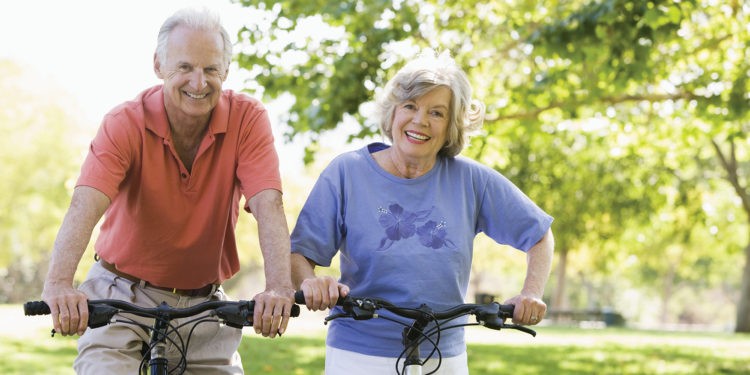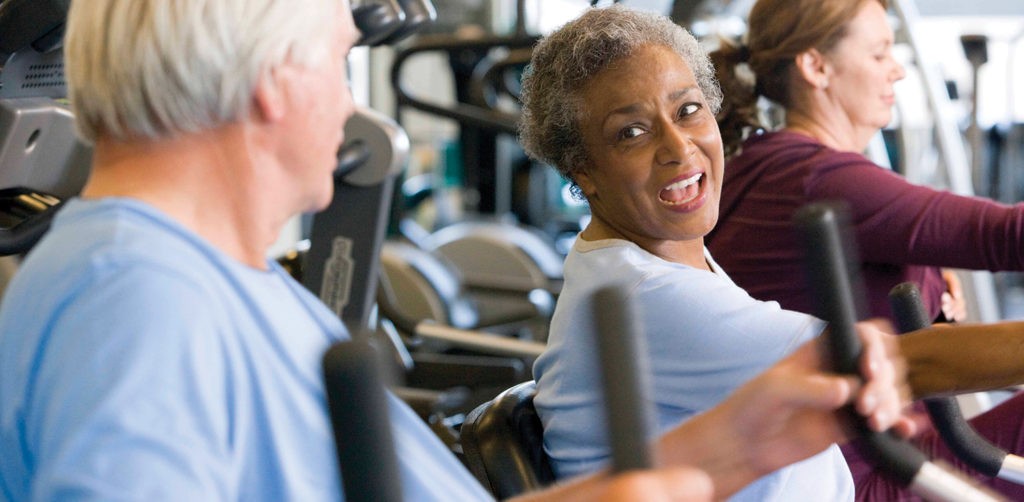Live as Young as You Feel

Staying Fit as a Senior
No one has the power to stop the aging process, but all of us possess the power to cause it to slow and reap some incredible benefits in the process. Staying fit is more than a doctor’s recommendation; it is your ticket to maintaining independence, protecting your heart, and managing symptoms of pain or illness. It is also great for your mind, mood, and memory. And the best part? You can start right now at any age or fitness level and reap serious rewards.
Healthy Aging
Astonishingly, 40 percent of Americans between 45 and 64 are considered sedentary. For people over 64, that number escalates to over 60 percent. That means a great number of us are settling for much less than our best life possible. Numerous studies show many of the characteristics associated with aging, such as difficulty walking long distances or climbing stairs and the loss of balance are all largely due to a lack of regular physical activity. Seniors who exercise regularly benefit tremendously, according to the Centers for Disease Control, and have even more to gain than younger people because they are at higher risk for the health problems which physical activity can prevent.
Regular physical activity is the surest route to enhancing your health and quality of life. A Swedish large pooled cohort study regarding exercise and mortality found that physical activity was the number one contributor to longevity, even if you don’t start exercising until your senior years. In fact, research has linked physical activity in delaying or preventing health issues such as diabetes, colon cancer, heart disease, and stroke. Physical activities such as walking and strength training improve muscle mass and bone strength which in turn improves posture, mobility, coordination and balance and reduces the likelihood of injuries caused by falling. Staying or getting active will also help maintain flexibility, strengthen your joints, and reduce the pain caused by arthritis.
Set Aside the Crosswords
Activities like puzzles and crosswords do a lot to keep your brain active, but if you really want to improve brain functions, set aside the puzzles and get out for a walk or swim. As beneficial as those activities are, nothing comes close to the beneficial effects exercise has on the brain. While new benefits are continuing to be discovered, already science has proven that it helps in brain functions as diverse as creativity, multitasking, and problem solving. Research also shows that it plays a role in helping to prevent memory loss, cognitive decline, and dementia. Some research even supports regular exercise playing a role in helping to slow the progression of brain disorders such as Alzheimer’s.

Long-Term Independence is a Great Fit
Increasingly, Americans are adopting an ageing in place model of senior life. This model allows a person to live as long and independently as possible in the residence of their choice and maintain the quality of life they always enjoyed. Staying physically fit makes this model possible longer as it helps you retain mobility and helps you stay healthier longer.
Finding Your Fitness Formula
There are many barriers to starting and maintaining a regular fitness routine, especially as a senior. Chronic health conditions, physical limitations, and even fear can all get in the way. Sometimes we just do not know where to begin, or know what activities we can do safely, or feel we have to measure up to the fitness standards we set as a younger person. Reaping the rewards of exercise does not require a strenuous or dangerous workout. It just requires adding more movement and activity to your life even in small ways. And it is never too late to start.
Fitness experts recommend seeing your general practitioner before starting a fitness program, and once you have your physician’s recommendations, begin to do the activities you feel most comfortable doing. If you are comfortable playing tennis, riding bikes, or going hiking, then get out in the sunshine and begin there. If you are more comfortable taking walks or swimming, begin there. Even being disabled does not have to hinder you from getting active, it just takes modifying activities to fit your abilities. At every fitness level, it is important to include activities that cover the four areas of fitness; strength, endurance, balance, and flexibility.
If you dread or even hate to exercise, you can sneak in increased activities by doing it while doing something else you enjoy. For example, you can take photographs while on a nature walk, or start a walking club that walks the mall or shopping center so you can enjoy the company of friends and window shop at the same time. Another way to increase your activity levels is by opting in when there is an opportunity, such as by walking the golf course instead of taking the cart, parking a little further in the parking lot, or walking the dog more frequently.
Adding Life to Your Years
Getting active, however, is not just about adding years to your life; it’s about adding life to your years. A good workout burns energy which allows you to fall asleep more quickly, sleep more deeply and wake feeling refreshed and energized. Staying active is also a major stress reliever and can help reduce feeling of sadness and depression by increasing the release of endorphins, those feel-good chemicals that boost happiness. The benefits have a snowball effect because when we are happier we are more confident and apt to partake in more enjoyable activities.
Staying fit contributes to your well-being at every age – and for seniors, a fit and active lifestyle is more important than ever.





